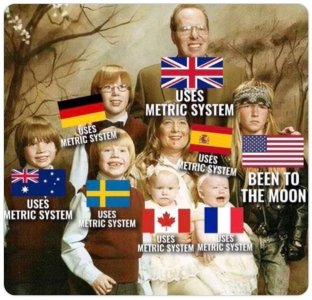Neapolitan Ice Cream
Delicious
- Joined
- Mar 18, 2021
- Messages
- 4,919
Here in the UK we're in a bit of a muddle when it comes to measurements. For medical purposes, our heights are measured in metric. Additionally, our temperature readings are taken in metric. And in school, mass as well as distance are all measured in metric.
HOWEVER.
Casual distance measurements, such as you might see on a motorway or road, are measured in imperial. Casually, we measure our heights in feet and inches. And sometimes, we still measure temperature in fahrenheit. It's as if we're trying to advance, but imperial measurements are holding us back.
Thoughts?
HOWEVER.
Casual distance measurements, such as you might see on a motorway or road, are measured in imperial. Casually, we measure our heights in feet and inches. And sometimes, we still measure temperature in fahrenheit. It's as if we're trying to advance, but imperial measurements are holding us back.
Thoughts?


 Yep. It’s a well-understood mishmash of what is official and how we actually think. Nigh on 50 years into the metric system officially, most of us still think in imperial for weights and measures, even young people, because that’s the way most things are practically described. We know exactly what we’re doing but it’s probably nonsense to outsiders.
Yep. It’s a well-understood mishmash of what is official and how we actually think. Nigh on 50 years into the metric system officially, most of us still think in imperial for weights and measures, even young people, because that’s the way most things are practically described. We know exactly what we’re doing but it’s probably nonsense to outsiders.
 First place I eve saw that was Disney and its spreading. So they can all it a pint but it looks wrong and feels wrong. A liter of beer is a liter of beer no matter where you go.
First place I eve saw that was Disney and its spreading. So they can all it a pint but it looks wrong and feels wrong. A liter of beer is a liter of beer no matter where you go.